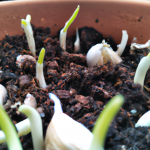Imagine a world where food is scarce and grocery store shelves are empty. A crisis has hit, and the comfort of having fresh produce at your fingertips is nothing but a distant memory. The thought may seem extreme or far-fetched, but it’s always better to be prepared for the worst. That’s why learning how to regrow lettuce from the base is a skill every self-reliant individual should have in their arsenal.
Regrowing lettuce from the base is a simple and cost-effective way to ensure a continuous supply of fresh greens, even in the face of a crisis. Lettuce is a staple of the modern diet, and having the ability to produce it in your own home without relying on outside sources is a game-changer.
Why Regrow Lettuce from the Base?
The main benefit of regrowing lettuce from the base is that it allows you to stretch your resources. When you regrow lettuce, you eliminate the need to buy new seeds or seedlings each time you want to grow more. Instead, you can use the base of a head of lettuce that you’ve already consumed to start the regrowth process. This not only saves you money but also reduces your dependence on external sources for your food supply.
In addition to being a cost-effective solution, regrowing lettuce from the base is also incredibly easy to do. It requires minimal tools and materials, making it accessible to anyone, regardless of their level of gardening experience. All you need is a container or a small pot, some water, and of course, a head of lettuce.
How to Regrow Lettuce from the Base
1. Start by selecting a head of lettuce that still has the base intact. Avoid using lettuce that has been sliced or chopped, as this may not regrow properly.
2. Cut off the leaves of the lettuce, leaving about 2 inches of the base intact.
3. Place the base in a container filled with about an inch of water. Make sure the base is submerged, but not completely covered.
4. Keep the container in a well-lit area, preferably near a window where it can receive ample sunlight. Lettuce thrives in cool temperatures, so make sure to avoid placing it in direct sunlight or in an area that is too warm.
5. Change the water every couple of days to ensure it stays fresh and clean. This helps to prevent any bacterial growth that could harm the regrowth process.
6. Within a few days, you will start to see new growth emerging from the center of the base. This is a sign that your lettuce is regrowing successfully.
7. Once the new leaves have grown to a substantial size, you can transplant the lettuce into a small pot filled with soil. Make sure to leave the tip of the leaves exposed, as burying them too deep can hinder their growth.
8. Water the lettuce regularly and continue to provide it with adequate sunlight. In no time, you will have a thriving lettuce plant that can be harvested for fresh, homegrown greens.
Conclusion
Learning how to regrow lettuce from the base is a valuable skill that can provide you with a consistent supply of fresh greens, even in times of crisis. By mastering this technique, you take one step closer to self-reliance and insulating yourself from the uncertainties of the future. Remember, being prepared is not about succumbing to fear but embracing the power of knowledge and self-sufficiency.
So, why not start regrowing lettuce from the base today and take control of your food supply? By doing so, you’ll be better equipped to handle whatever challenges may come your way.




GIPHY App Key not set. Please check settings